MARIANI’SVirtual Gourmet
May 13,
20012
NEWSLETTER
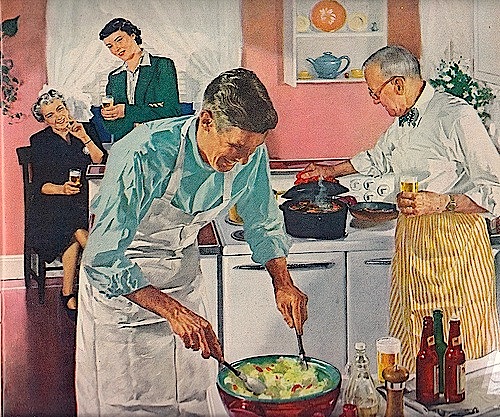
Happy Mother's Day!
❖❖❖
THIS WEEK
by John Mariani
NEW YORK CORNER
Vitae
by John
Mariani
NOTES FROM THE
WINE CELLAR
Sequoia Grove Comes Back to Favor
in Napa Valley
by
John Mariani
❖❖❖
EATING OUT
ON TAIWAN
by
John Mariani
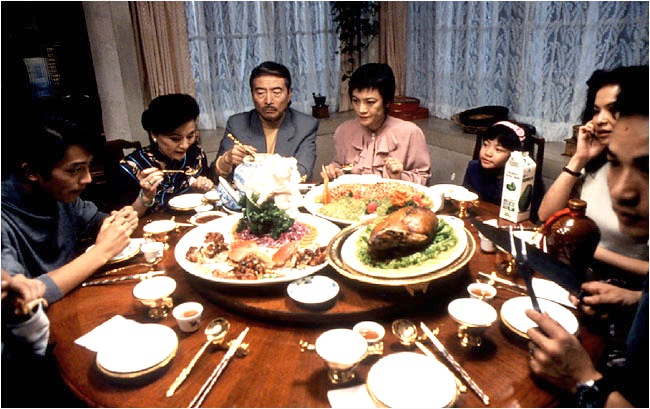
"Eat
Drink Man Woman" (1994), directed by Ang Lee
Taiwanese
love nothing more than entertaining friends--and
travelers--according to the custom of qingke, "playing
the host." Within that custom are rituals of
seating, toasting, even paying the bill, and if
invited to a banquet of a dozen dishes or more, it
might be wise to learn a few of them or ask what not to do.
For one thing, liquor and wine, even beer, while
available, are not necessarily served or offered; it
is, however, perfectly all right to
ask. An
appropriate tea will be served.
The host will do the toasting,
which will usually be the phrase "gam bei," which
means "dry cup," meaning guests should drink it all,
kind of like "down the hatch!" If you wish to
toast your host, say su'i, which means "sip."
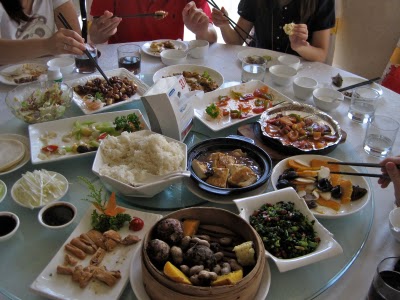 You may notice that the host and chief
guest will be opposite each other, the host with his
back to the door. Other guests not quite so important
will flank the host, more often than not at a round
table, with a lazy Susan (left). You should certainly
learn to use chop sticks, and if you're eating at a
restaurant and have a rice bowl, food taken from the
lazy Susan should be placed in small portions atop the
rice. The bowl is then brought close to the
mouth and the food eaten. Do not take the whole
plate from the lazy Susan.
You may notice that the host and chief
guest will be opposite each other, the host with his
back to the door. Other guests not quite so important
will flank the host, more often than not at a round
table, with a lazy Susan (left). You should certainly
learn to use chop sticks, and if you're eating at a
restaurant and have a rice bowl, food taken from the
lazy Susan should be placed in small portions atop the
rice. The bowl is then brought close to the
mouth and the food eaten. Do not take the whole
plate from the lazy Susan.
There is also a tradition to the
service of specific dishes, not unlike Western
culture, so that you begin with non-oily dishes, lead
up to them heavier dishes mid-meal, then end with more
non-oily items. Spicy may be followed by sweet.
Desserts are more an adaption of Western appetites,
but more and more, particularly on Taiwan, you'll find
sweets served at meal's end. What you
should not ask for is rice at a banquet, which is
considered too common a food for such a meal.
One difference you may find
between dining out on Taiwan and dining out on the
Mainland is the condition of the tablecloth itself at
meal's end. On the Mainland it is considered
perfectly acceptable, even polite, to leave something
of a spotted mess. I did not find this always to
be the case at my meals in Taipei, though there is a
tendency to use flimsy paper rather than cloth
napkins, which makes keeping the table spotless next
to impossible. Dishes from various courses are also
not removed unless you tell them you've finished.
There's not much more you need to
know except that the Taiwanese would never be so
discourteous as to express disfavor with Westerners'
behavior; they tend to suggest rather than reprimand,
and Taipei, being the 21st century city that it is,
has become more than a little Westernized. The people
there have come to love French desserts, Italian
pizza, and American hamburgers, along with breads,
croissants, and chocolates. There is no grape
wine produced on Taiwan--though, as I mentioned in the
first part of this article, they do make whiskey--so
buying European wines, while not cheap, is possible.
Eastern China does produces shao-xin, a mahogany-colored rice
wine called "daughter red," which is served when a
daughter 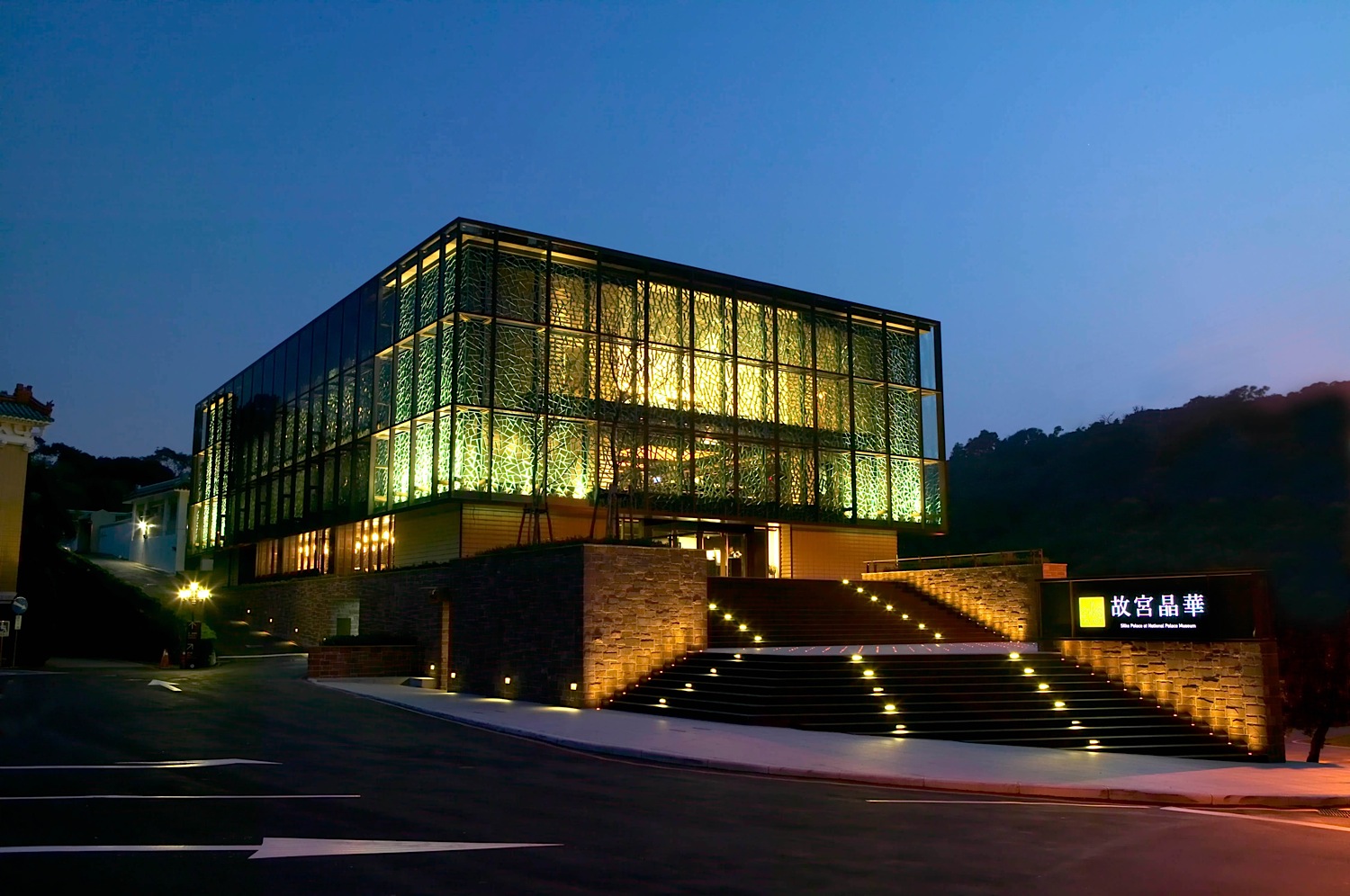 is born and
gets married; if she dies, it is referred to as
"flower withering."
is born and
gets married; if she dies, it is referred to as
"flower withering."
On a recent trip I dined mostly in
Taipei, which is very rich in thousands of restaurants
expressive of all styles of cooking in China, from
Sichuan to Cantonese. Taiwanese cooking is,
generally speaking, now somewhat lighter than on the
Mainland, and freshness of ingredientsis paramount
here, which can be seen from the various indoor food
markets whose pristine, sanitary conditions are backed
by careful municipal monitoring----certainly
not a given
on the Mainland.
My first meal upon arrival was at
the five-story Silks Palace Restaurant
(right),
located across from the National Palace Museum.
The grandeur of the restaurant, which glows at night
with its own interior light and during the day
shimmers with sunlight through glass walls and
corridors (below),
with five restaurants and a gourmet food court. Every
detail, from chinaware and silverware are designed
from antique originals. The exterior alone makes for a
stunning sight; inside, hallways of Ju Kilm ware wall
frosting, pillars of Liang-chu period columns, a
famous painting called "A Palace Concert" from the
T'ang Dynasty hangs on wall wall, and lights are
shaped like Tsung-chou bells. There are
calligraphic scrolls of Chinese poetry, artwork done
in cut paper and ground glass lighted from
behind. All this impressive décor is
followed through in the restaurant's service and
exquisitely designed food, which I enjoyed as part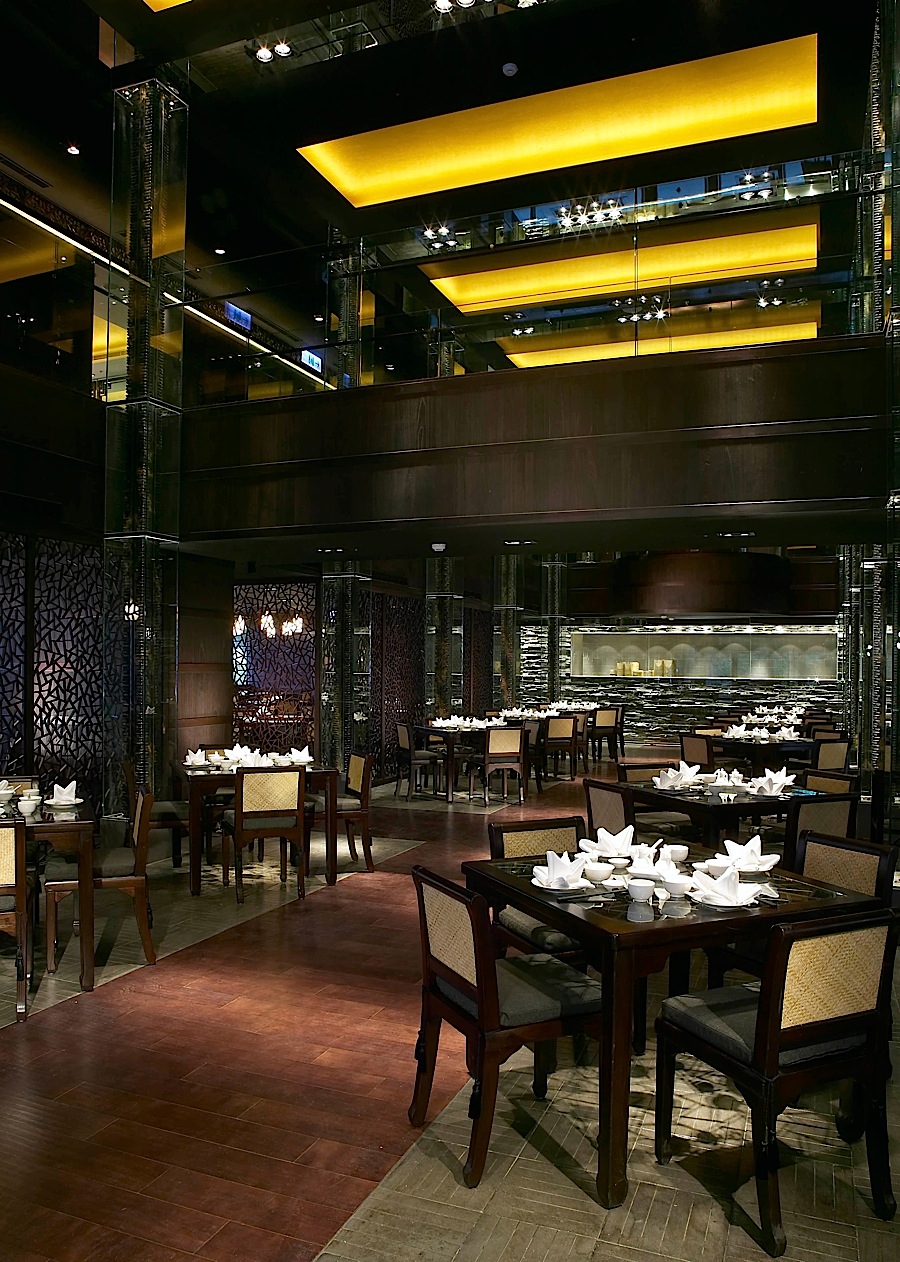 of a banquet
held by my hosts. Dish after beautiful dish came
through the doors of our banquet room, one of
ten, each dish a little work of art.
Indeed, Silks Palace offers dishes as part of its
Imperial Treasure Feast, whose design mimics
masterpieces of Chinese sculpture and artwork from the
museum, such as a Jade Cabbage with Insects from the
Ch'ing Dynasty, emerging on the banquet table as bok
choy heart boiled in a chicken and ham broth and
served as a salad with black sesame sauce, the
"insects" composed of tiny shrimp. In a cunning
give-and-take of trompe l'oeuil food art, dongpo meat from
the pig's knuckle is stewed then carved into the shape
of a Ch'ing Dynasty sculpted stone itself made to look
like fatty meat of various colors.
of a banquet
held by my hosts. Dish after beautiful dish came
through the doors of our banquet room, one of
ten, each dish a little work of art.
Indeed, Silks Palace offers dishes as part of its
Imperial Treasure Feast, whose design mimics
masterpieces of Chinese sculpture and artwork from the
museum, such as a Jade Cabbage with Insects from the
Ch'ing Dynasty, emerging on the banquet table as bok
choy heart boiled in a chicken and ham broth and
served as a salad with black sesame sauce, the
"insects" composed of tiny shrimp. In a cunning
give-and-take of trompe l'oeuil food art, dongpo meat from
the pig's knuckle is stewed then carved into the shape
of a Ch'ing Dynasty sculpted stone itself made to look
like fatty meat of various colors.
In addition there were more
traditional dishes that included an array of
appetizers like sweet-sour pork soup; jellied pork
cakes; "drunken" chicken; egg white porridge, and
more. Main courses included pork tendons in hot
chili; steamed yellow croaker; stewed meatballs with
crab; pork dumplings; and scallion pancakes, on Taiwan
made thicker than on the Mainland. Dessert was a
remarkable piece of pastry art--seemingly a big paint
brush, but actually a log of peanuts, jelly and
coriander.
First-rate
seafood abounds on Taiwan, its shoreline rippled and
jagged with inlets, coves, and harbors, allowing for a
bounty of fish, crab, mollusks, and other sea
creatures. One of the best places--always
packed--to find them all is Shin Tung Nan, whose own market stalls
(below) lie
just outside the front door. The big room is
very cheery, the banquet tables off to one side,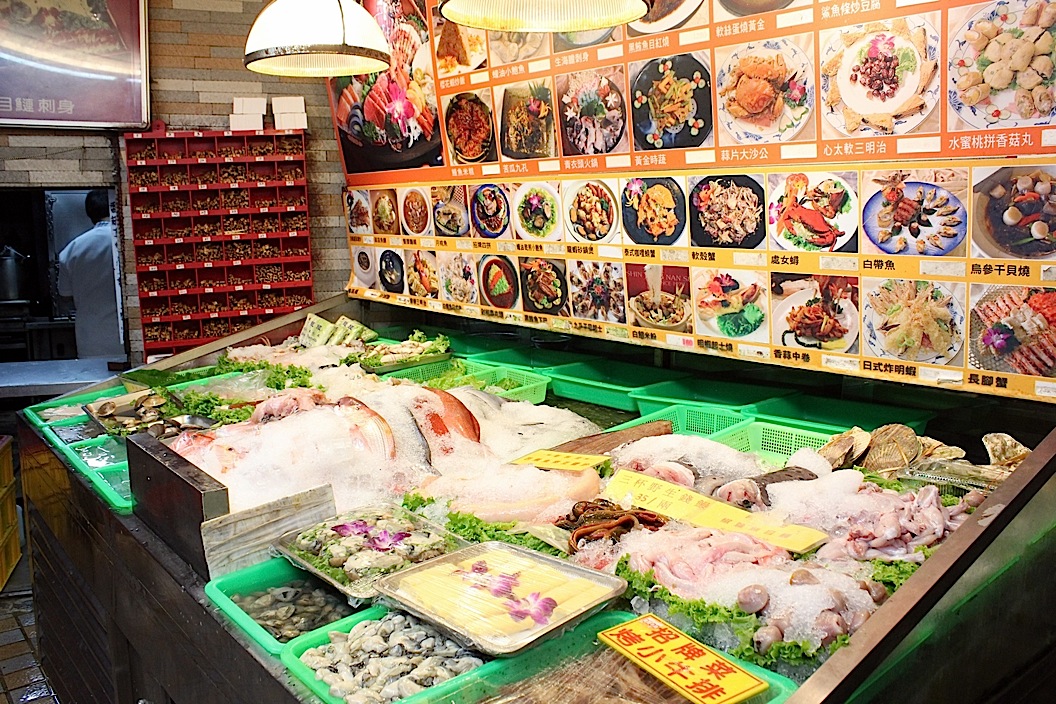 and the food comes at a
clip. From the cold dishes to the steamed dishes to
the fried dishes, everything was elegantly presented.
lusty and generous in portions, and quite creative,
from stir-fried squid with a hot, spicy sauce to
softshell crab crusted with crispy garlic. The
cost of a meal that extended to about a dozen courses
that including high-priced items like crab, with beer
and 10 percent service charge, worked out to about
US$25 per person--an amazing bargain! Prices are this
remarkable all over Taiwan.
and the food comes at a
clip. From the cold dishes to the steamed dishes to
the fried dishes, everything was elegantly presented.
lusty and generous in portions, and quite creative,
from stir-fried squid with a hot, spicy sauce to
softshell crab crusted with crispy garlic. The
cost of a meal that extended to about a dozen courses
that including high-priced items like crab, with beer
and 10 percent service charge, worked out to about
US$25 per person--an amazing bargain! Prices are this
remarkable all over Taiwan.
After a visit to the Night Market,
we went above the street to Formosa Chang,
which has 36 branches, two in Japan. Chang has
its fast food aspect, including boxed lunches for
school children, but its traditional restaurant
cooking is well respected by Taiwanese and known for
specialties like minced pork fried rice; bean curd
cooked in a rich broth; steamed meat and seafood
casseroles, and for the adventurous, pork
intestine--what we call chitterlings--in an herb soup
(below).
My favorite among many dishes was Chang's braised pork
knuckle in soy sauce with shredded greens.
Prices are amazingly low--that last dish was US$2.39.
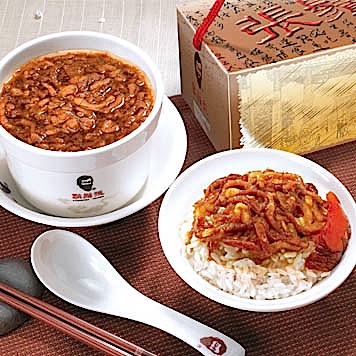 No one visiting
Taiwan should miss the huge, fast-paced dim sum palace
called Ding
Tai Fung,
also a multi-branch concept, with restaurants in
Malaysia, Japan, Korea, Australia, China, Singapore,
Thailand, Indonesia, the USA (Arcadia, CA, and
Seattle), with six in Taiwan.
No one visiting
Taiwan should miss the huge, fast-paced dim sum palace
called Ding
Tai Fung,
also a multi-branch concept, with restaurants in
Malaysia, Japan, Korea, Australia, China, Singapore,
Thailand, Indonesia, the USA (Arcadia, CA, and
Seattle), with six in Taiwan.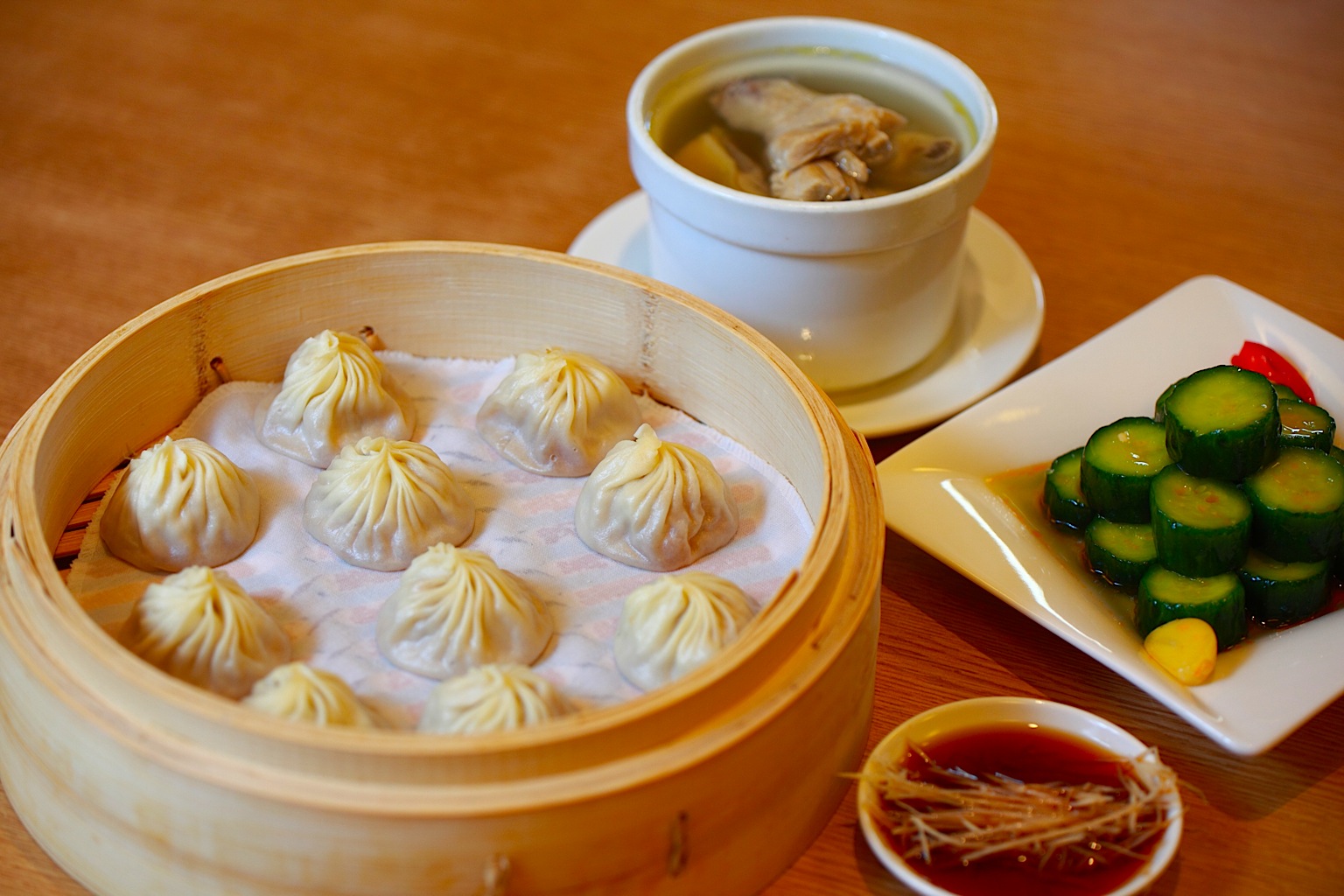 The most spectacular is on the lower floor of the
Taipei 101 skyscraper, and by noontime the 330-seat
restaurant is flooded with shoppers, locals, business
people, and students who come ravenous for the array
of dim sum offered here. On any given day there
are a dozen varieties of dumplings (right), all
thin-sheeted, each juicy, from the steamed shrimp and
pork shiaomai
and the truffle and pork Xiaolongbao to the loofah and shrimp
soup dumplings to the shrimp and pork pot
stickers. There is also a selection of 10
steamed buns, packed with everything from sesame and
taro to red beans and pork.
The most spectacular is on the lower floor of the
Taipei 101 skyscraper, and by noontime the 330-seat
restaurant is flooded with shoppers, locals, business
people, and students who come ravenous for the array
of dim sum offered here. On any given day there
are a dozen varieties of dumplings (right), all
thin-sheeted, each juicy, from the steamed shrimp and
pork shiaomai
and the truffle and pork Xiaolongbao to the loofah and shrimp
soup dumplings to the shrimp and pork pot
stickers. There is also a selection of 10
steamed buns, packed with everything from sesame and
taro to red beans and pork.
Yet the offerings don't stop there.
Ding Tai Fung also has a large menu of other items,
from appetizers like pickled mustard greens with
minced pork and wine-marinated chicken slices to fried
pork chops and braised bitter melon. If you've
restrained your dim sum intake, you might also try
main courses like shrimp fried rice or one of the
noodle soups. Then there are the wontons,
too. It's an astounding tour de force, but
practice has made perfect when it comes to the dim
sum, which you can watch being made by masked cooks
behind a glassed-in kitchen (left). There are 36 different beers
to go with the food here, which uses more vinegar than
soy sauce than common elsewhere in China.
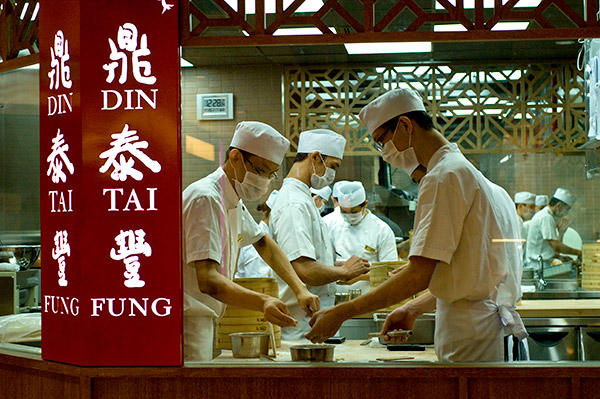 A
trip to the countryside of Luodong brought us to a
remarkable teppanyaki restaurant named Shen Yen run by a
young chef named Cheng Zhi-yong (below), who was
born in the village. After years of training in many
kitchens, he opened his own a decade ago, and despite
its remote location, it always fills up for lunch and
dinner. When you enter the broad dining room
you'll see a refrigerator full of fine French wines,
which would indeed go well with Zhi-yong's simple,
impeccably seasoned cooking on the teppanyaki griddle.
He locates himself behind it, quietly telling his
staff to bring this or that fish, which he himself
chose that morning at the seafood market.
A
trip to the countryside of Luodong brought us to a
remarkable teppanyaki restaurant named Shen Yen run by a
young chef named Cheng Zhi-yong (below), who was
born in the village. After years of training in many
kitchens, he opened his own a decade ago, and despite
its remote location, it always fills up for lunch and
dinner. When you enter the broad dining room
you'll see a refrigerator full of fine French wines,
which would indeed go well with Zhi-yong's simple,
impeccably seasoned cooking on the teppanyaki griddle.
He locates himself behind it, quietly telling his
staff to bring this or that fish, which he himself
chose that morning at the seafood market. 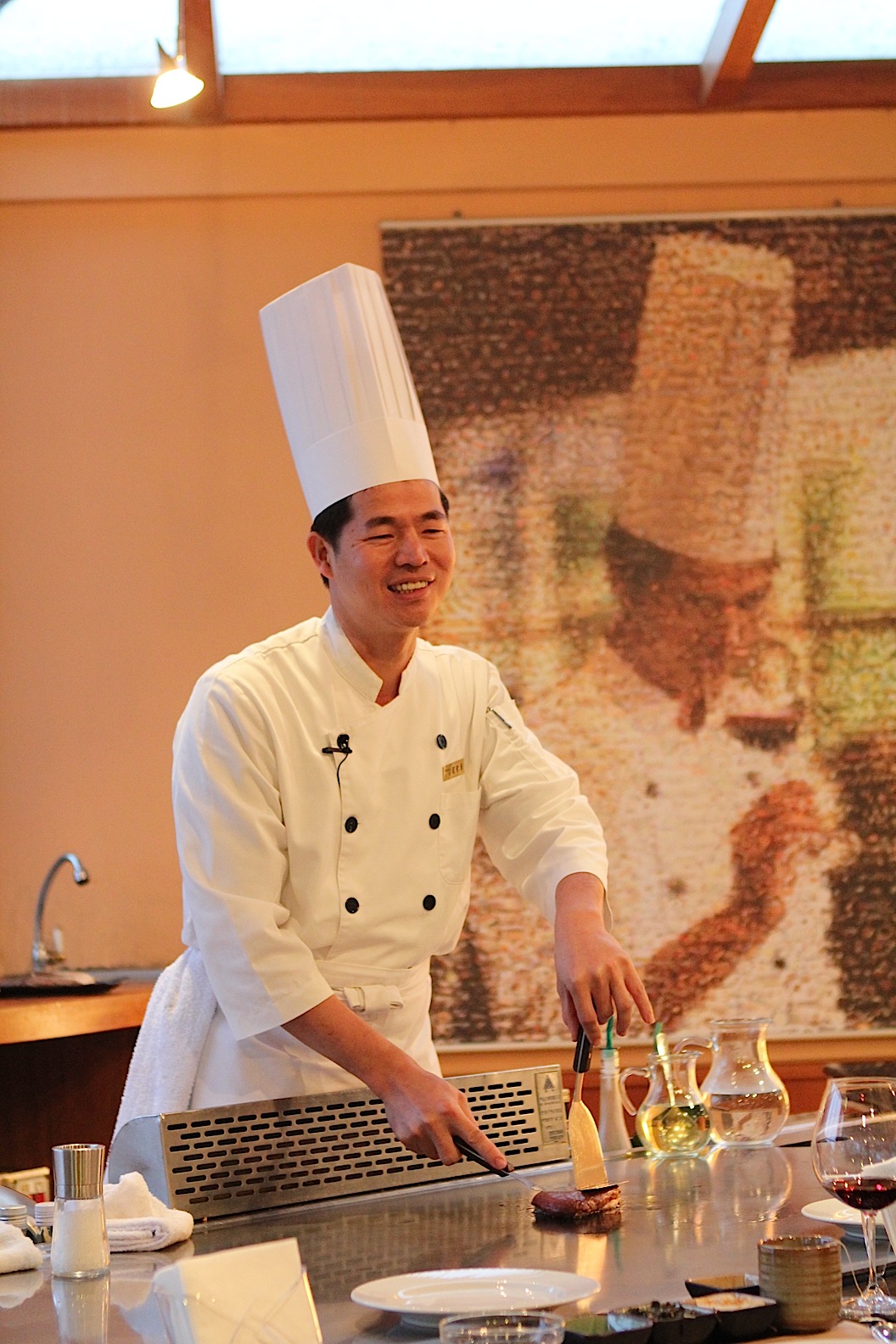 He also makes
his own array of soy sauces using different salts that
go with different species.
He also makes
his own array of soy sauces using different salts that
go with different species.
Over a two-hour meal I was
fascinated by the depth and breadth of Zhi-yong's
artfulness. We began with sashimi-style porgy and
threadfin, sliced somewhat thicker than in
Japan. He cooks wild eel a very long time to
tenderize it then serves it with six-month old soy
sauce. There was also a sliced boletus-like mushrooms,
though very large, followed by amberjack, red croaker,
a rather bland seafood soup, and then American Kobe
beef--a surprise, certainly-- wrapped around Canadian
foie gras--an even bigger surprise.
My
last meal on Taiwan was something I had been
craving--hot, very spicy Sichuan food. The
seasonings up till then in all my meals had been
delicious but fairly mild, and I really wanted to end
off with an eye-watering bang. So, on a Friday
evening, we sat in a packed dining room at W'ei, whose
tableside service left something to be desired but
whose food was fabulous. It's all run by women, some
of them snapping orders, others rushing out plates of
food, opening beer bottles, pouring tea. 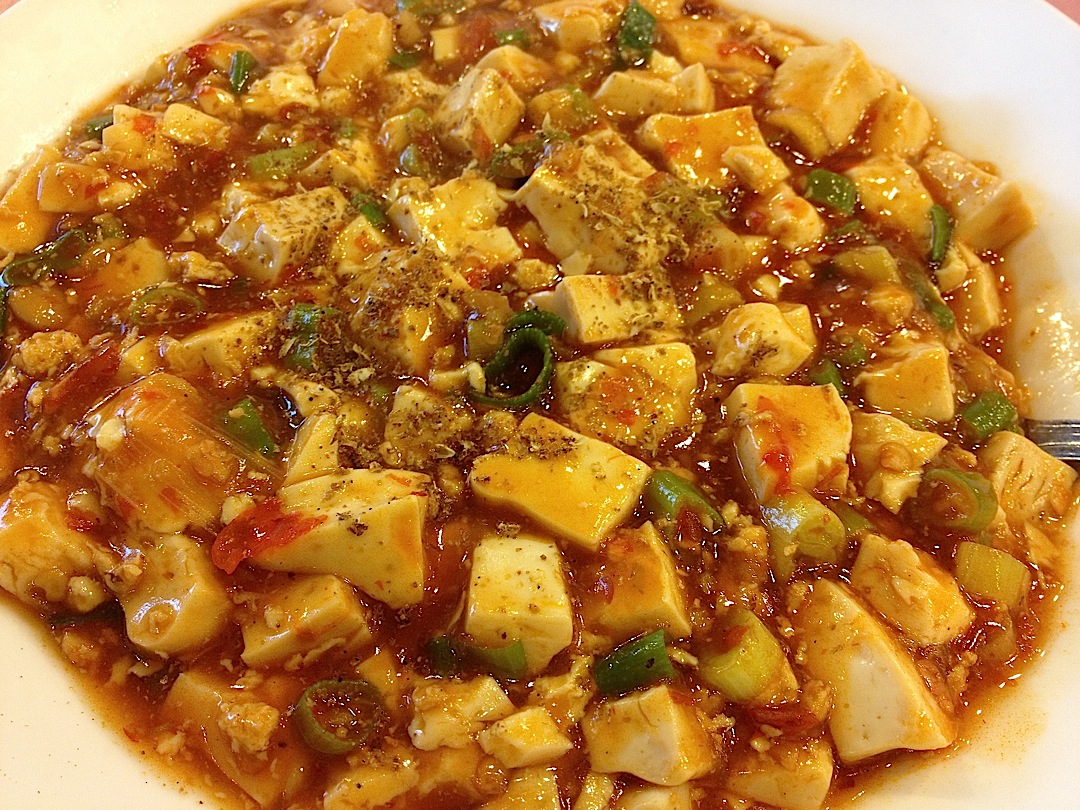 We began with pork in an
assertive garlic sauce, then cold oily chicken. Lush
bean curd came with peppers and minced pork (left).
Steamed fish came with crunchy soy powder, the whole
very succulent and a good balance to the pork. Sweet
dry green beans were flash-fried, and pea noodles came
with minced pork in the traditional rendering what is
called "Ants Climbing a Tree." Fried rice with pork
had a strong egg flavor, and we ended off with kung pao shrimp
with fiery shards of chili peppers and an abundance of
crunchy peanuts.
We began with pork in an
assertive garlic sauce, then cold oily chicken. Lush
bean curd came with peppers and minced pork (left).
Steamed fish came with crunchy soy powder, the whole
very succulent and a good balance to the pork. Sweet
dry green beans were flash-fried, and pea noodles came
with minced pork in the traditional rendering what is
called "Ants Climbing a Tree." Fried rice with pork
had a strong egg flavor, and we ended off with kung pao shrimp
with fiery shards of chili peppers and an abundance of
crunchy peanuts.
I have sometimes wondered if I
would tire of Chinese food after a few days of it, but
the variety of options, the array of exotica, and the
regional styles of cooking I found on Taiwan only made
me hungry for more. When I got home, I already
missed it.
❖❖❖
NEW
YORK CORNER
by
John Mariani
VITAE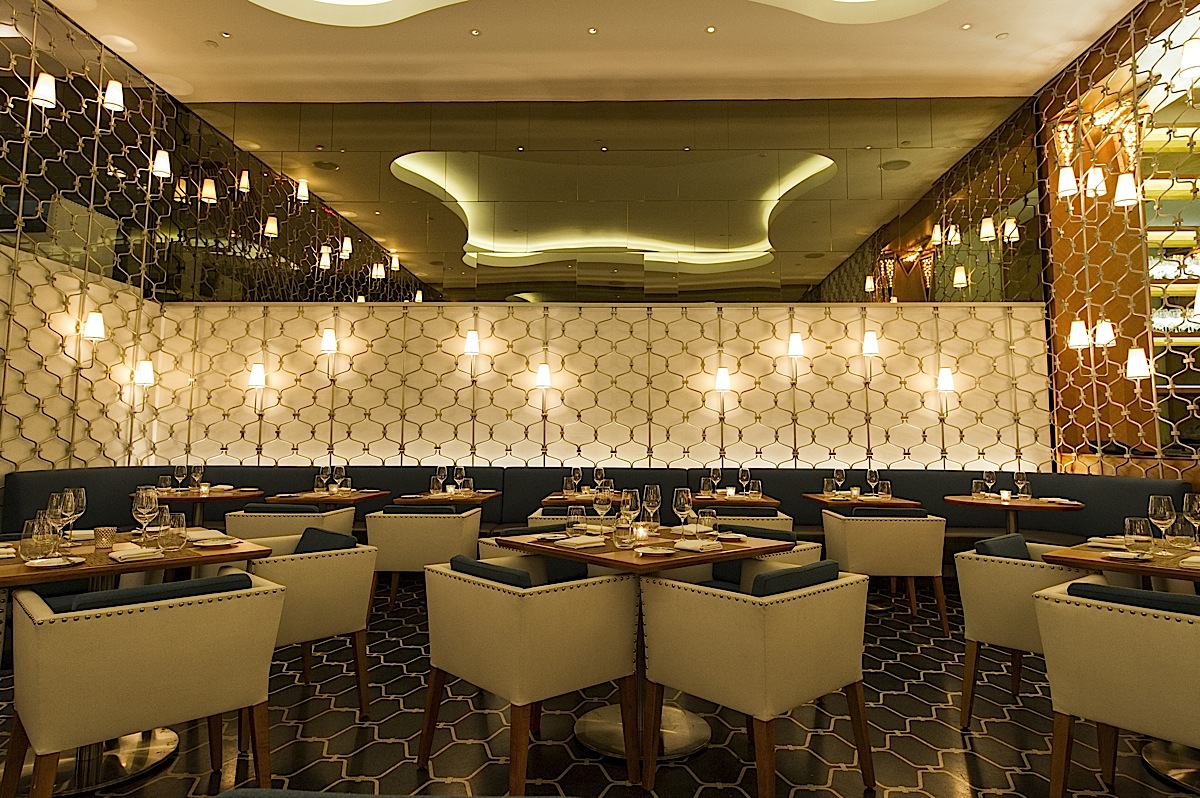
4 East 46 Street (near
Fifth Avenue)
212-682-3562
www.vitaenyc.com
Vitae
sits on a corridor one would think is prime real
estate--one street over from Grand Central, three from
Broadway theaters and Rockefeller Center, and half a
block from Madison Avenue's retail stores. Yet
it has never been a bright spot for fine restaurants,
and with so many places to eat at Grand Central and
the MetLife Building, Vitae's chef-owner Edwin
Bellanco is taking a bold step moving here. On
the basis of a recent visit, I think it's taken flight
soon and well.
Vitae is set on two floors, with 90
seats spread over a long bar, a downstairs dining room
and a mezzanine (preferable for its lower noise
level), with a staircase that must keep the service
staff's legs in peak shape. The décor
will be a matter of taste: it's a retro 1960s look,
with a pattern of interlocking nickel hexagons and
mirrored walls that remind me of Gucci's horse
bit motif, a lounge at JFK Airport when it was called
Idlewild, or Dean Martin's swinging bachelor's pad
circa 1962. A cut-out ceiling on the mezzanine throws
a soft light and the banquettes and seating throughout
is extremely comfortable.
The service staff, overseen by the
very cordial manager/beverage director Emily Iverson,
is fast-paced--it has to be coming and going up those
stairs, the winelist is well balanced in price and
categories, and the music is general gregariousness of
the place infectious.
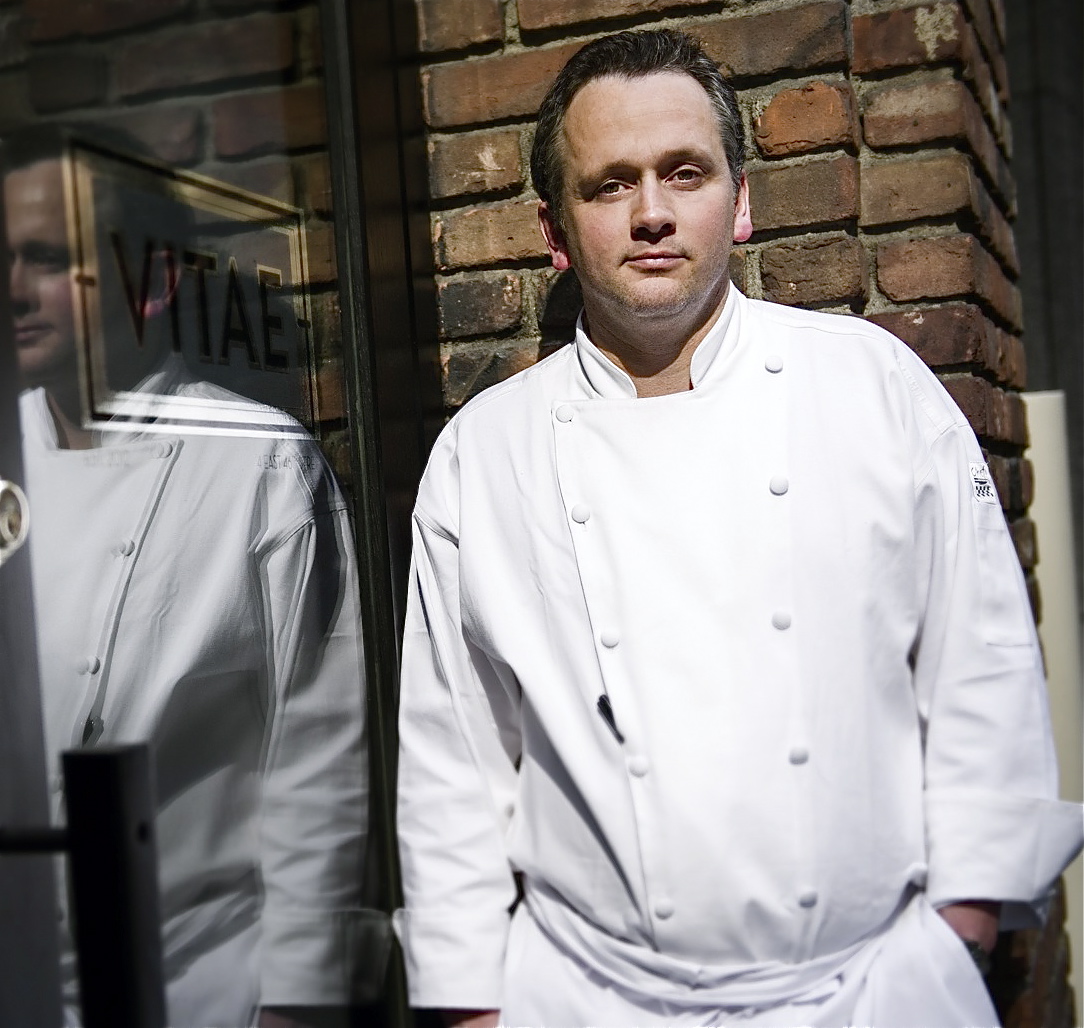 Bellanco (left) is a true
veteran of the professional kitchen, with stints and
positions with restaurants run by David Bouley, Tom
Colicchio, Danny Meyer, Marco Canora, Shea Gallante,
and Thomas Keller, and all that work has given his
cooking a precision and refinement that make Vitae an
exceptionally strong opening in midtown, which hasn't
had many in the past few years.
Bellanco (left) is a true
veteran of the professional kitchen, with stints and
positions with restaurants run by David Bouley, Tom
Colicchio, Danny Meyer, Marco Canora, Shea Gallante,
and Thomas Keller, and all that work has given his
cooking a precision and refinement that make Vitae an
exceptionally strong opening in midtown, which hasn't
had many in the past few years.
The menu is a very sensible size,
with nine entrees. meaning that the kitchen can take
care with each one. My first bite of my first course
was sensationally good: Bellanco redeemed my regard
for sea scallops, which are so ubiquitous on menus, by
combining them with contrasting flavors of
cauliflower, golden raisins, cashews, and a fine Thai
curry sauce, all of which brought up the sweetness of
the scallop (below). Pulled tacos were
sublimated by a polenta tuile, tomato marmalade, and
avocado. Three excellent pastas followed--veal
cheek agnolotti in a Parmesan broth with spring's fava
beans and ramps; ricotta gnudi with a bright walnut
pesto and the bite of chorizo; an spaghetti alla
chitarra with delectable little chicken-ricotta
meatballs, chick peas, more favas, and a rich
soffrito. Only a risotto of rock shrimp was
disappointing, the rice overcooked that evening, 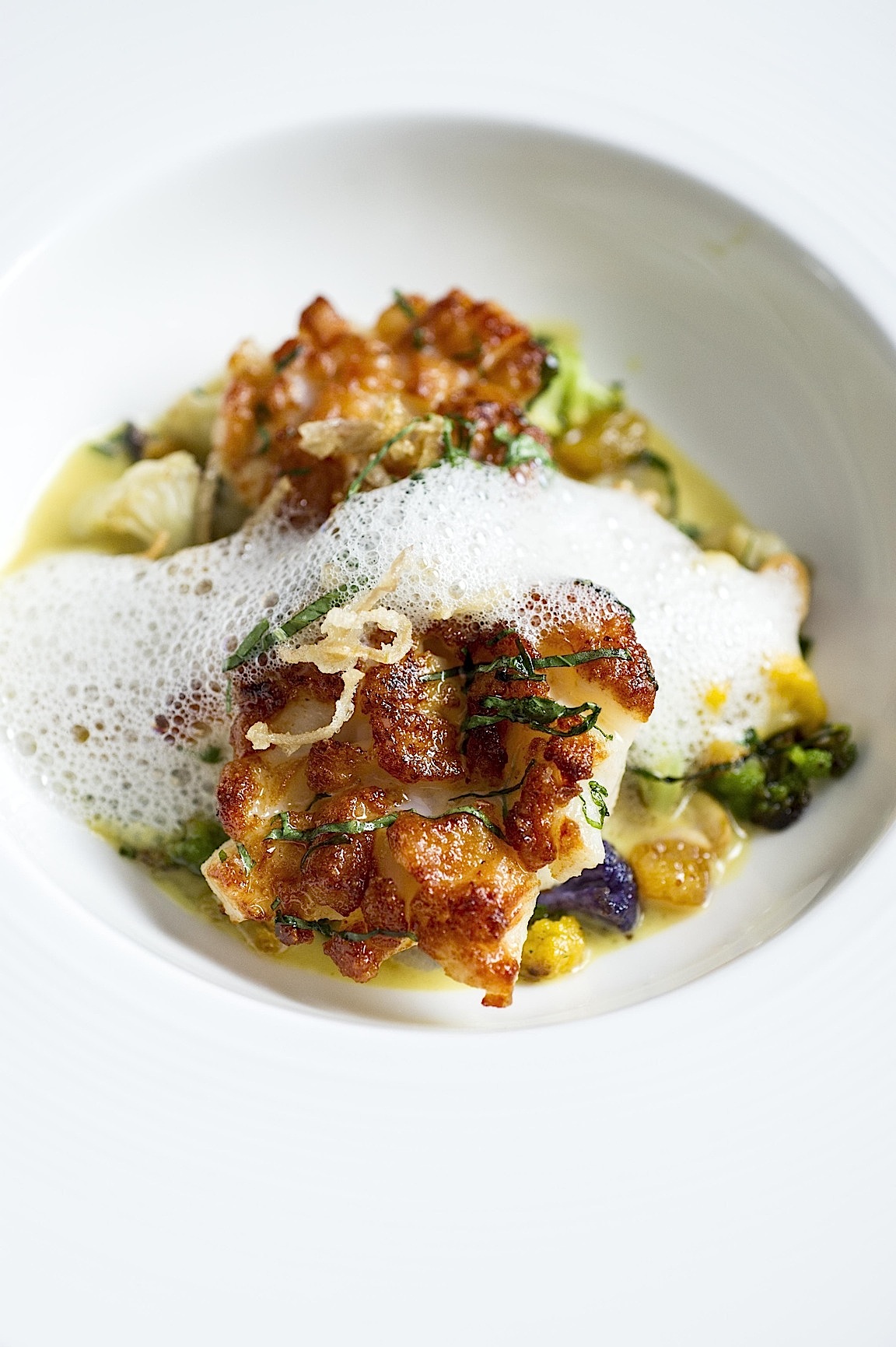 and the saffron tasting almost
medicinal.
and the saffron tasting almost
medicinal.
For main courses the striped bass
was perfectly cooked, with cremini mushrooms,
kohlrabi, asparagus and ramps, as was swordfish
with potato salad and parsley sauce, both dishes
emphasizing the fish's flavors, not overpowering
them. A Niman Ranch ribeye was all I
expected--succulence and fat in tandem, fully
flavorful, with watercress, excellent French fries,
and a rich, creamy Bearnaise. Lamb loin, requested
medium rare came out almost entirely raw, which was
not pleasant, wrapped in a crêpinette with
favas, spring onions, and Mediterranean a notes of
yogurt, feta, and mint.
We also ordered a side of potato
puree, but it might have been better described as
butter puree with potatoes whipped in--a melange for
which I have no complaints at all. It was
addictive.
A chocolate soufflê with
espresso crème anglaise and whipped cream went
fast at our table, and a tarte Tatin was textbook if
nothing out of the ordinary.
Bellanca proves himself one of
those chefs who give New York its mass quantity of
pros who have learned everything from the masters and
have gone on to be masters themselves. He's a
guy you've got to keep your eye on.
Hours Continuous service Mon.-Sat., 11:30am to
11pm. Closed Sundays. Appetizers $12-$18,
entrees $24-$55; $24 pastas may be had as half
portions.
❖❖❖
Sequoia
Grove Comes Back to Favor in Napa Valley
by John Mariani
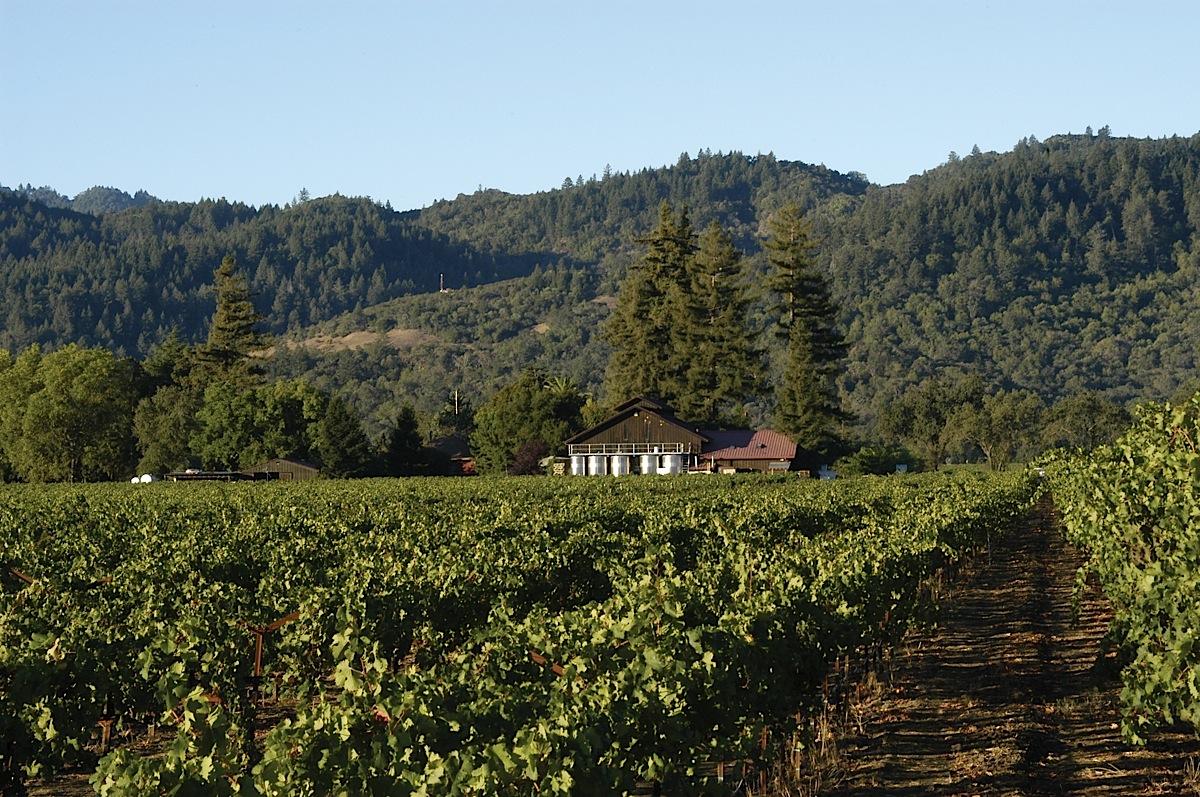
Trujillo, 50, has been Sequoia
Grove’s winemaker since 1998, having grown up a family
ranch in La Jara, Colorado, then studying engineering
before a chance visit to Sequoia Grove led the owner,
Jim Allen, to offer him a job. Trujillo went on to
study winemaking at the U. of California Davis and the
Napa Valley School of Cellaring. After Kobrand
Corporation bought the vineyard in 2001, Trujillo took
over all winemaking and company decisions. His first
vintage was in 2002. Since then he has been working to
buy small estate holdings on which to improve the
label’s quality and image.
Currently the winery sits on 22 acres in the
Napa Valley region called the Rutherford Bench, known
for producing excellent California cabernet
sauvignons. Trujillo also buys grapes from other
vineyards in the valley to make cabernets in the
blended, Bordeaux style.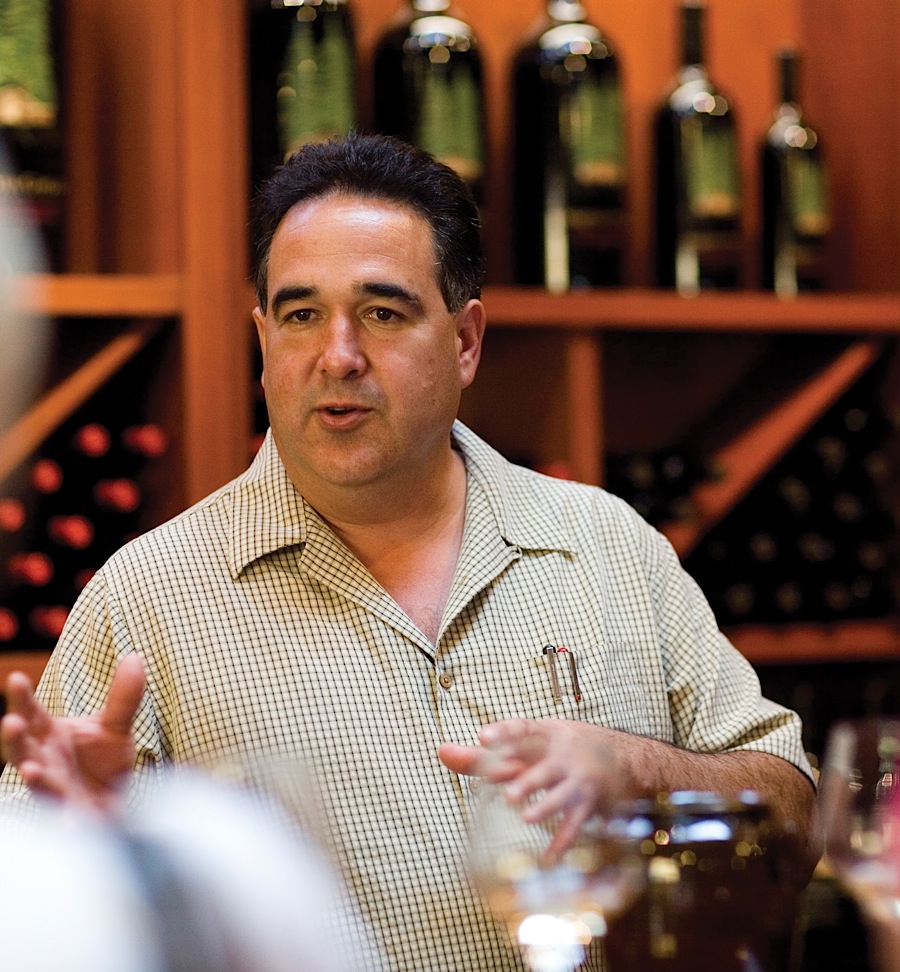
It was a taste of Sequoia Grove’s Napa Valley
label—its workhorse label, selling for about $38—that
convinced me that the winery has indeed come a long
way from those days when quality varied and its
reputation had foundered. The wine is not the
greatest California cab I’ve tasted, but it has all
those qualities that on the one hand show how the
blending of other grapes with cabernet adds complexity
and levels of flavors, while on the other proves that
a California cab need not be a blockbuster wine
weighing in above 15 percent alcohol. This Sequoia
Grove example was a robust but reasonable 14.2
percent; its single estate bottlings, like Cambium and
Stagecoach, top out about 14.5.
“A lot of Napa Valley wineries are still trying
to capture a few palates accustomed to that massive,
in-your-face style of cab,” Trujillo told me, “but I
look for balance and structure, seamless wines with
great length of finish. I’m after the guy who wants
flavor, not overripeness in a wine. Those who make
those huge cabs hang on one man’s word,” referring
without name to wine critic Robert Parker, Jr.,
considered to give high alcohol blockbusters very high
scores.
“High alcohol is not a vehicle for making a
wine that’s going to last a long while. Such wines
taste pleasantly sweet at first, and people like that
in the first glass.
But the wines don’t age well. I have no problem
adding water during fermentation if the alcohol is too
high. Or I cut those big boys out of the herd.”
The California problem is
that while grapes achieve what’s called “phenolic
maturity” through gradual sugar accumulation in cooler
climates like Bordeaux (where wines typically have 12
to 14 percent alcohol), in hot climates like Napa
Valley, grapes only reach maturity at higher sugar
levels later in the fall, and those sugars ferment
into high alcohol. Picking so late in the harvest can
also decrease desirable acids, which give wines their
fresh, bright flavors.
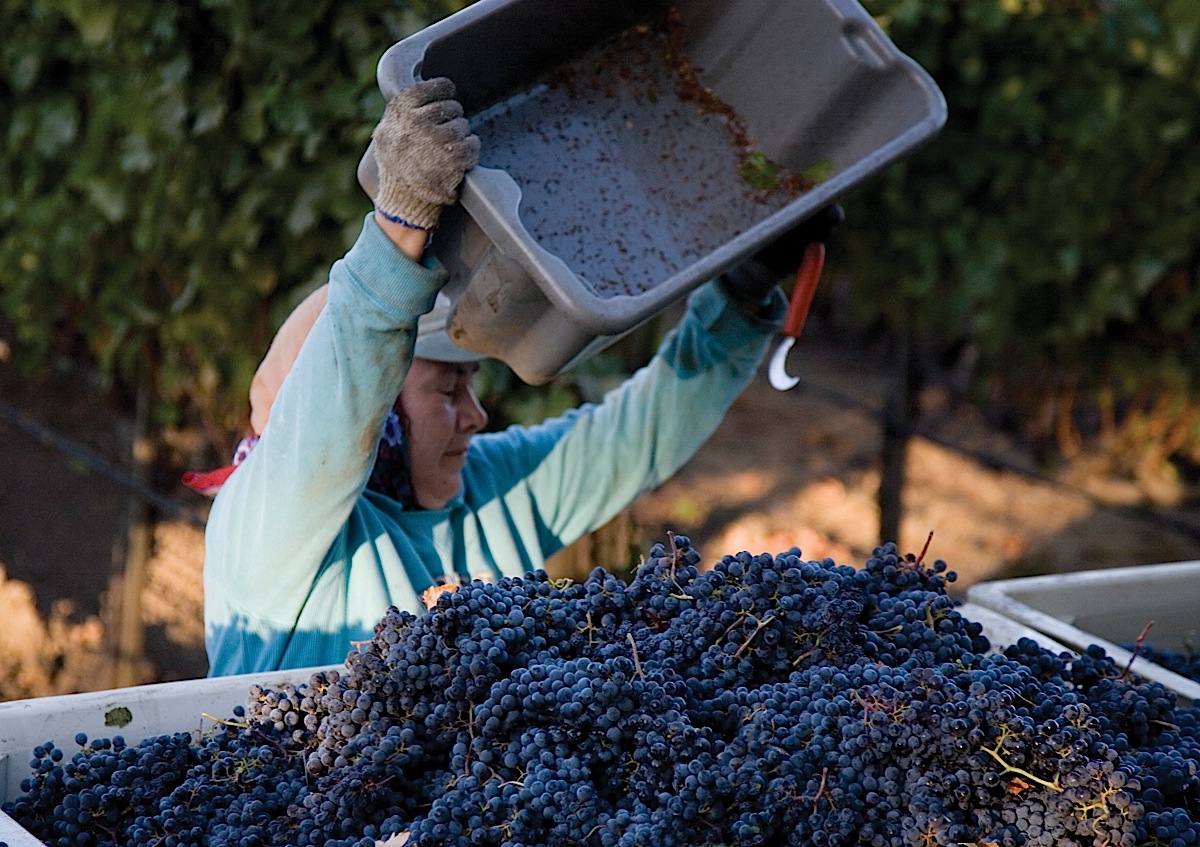 “I have no
problem picking early,” says Trujillo, “but 2007 was
such a perfect gift of weather, Mother Nature just
handed it to us on a silver platter. In 2007 anyone
could make good wine. It was a steady growing season,
no big heat waves, no spikes in the sugars, and we
picked early.”
“I have no
problem picking early,” says Trujillo, “but 2007 was
such a perfect gift of weather, Mother Nature just
handed it to us on a silver platter. In 2007 anyone
could make good wine. It was a steady growing season,
no big heat waves, no spikes in the sugars, and we
picked early.”
I asked Trujillo why, given his antagonism
towards overripe red wines, does he continue to make a
Sequoia Grove chardonnay that tilts above 14 percent
alcohol. “In one sense that was the style I was
handed,” he explains, “but I’ve been aiming to get the
big flavors of a great white Burgundy that isn’t
spoiled by too much oakiness.” He also does not allow
the wine to go through what is called malolactic
conversion, whereby acids are reduced. “I want it to
be a warm and fuzzy wine.”
Sequoia Grove’s popularity and reputation have
improved to the point where 80 percent of its
bottlings are sold on premises at the winery or
through a wine club offering members first pick of the
new releases. Trujillo
is especially excited about Cambium, of which he made
only 350 cases last year, selling for a whopping $140
a bottle.
“I figure I’ll have to row pretty hard 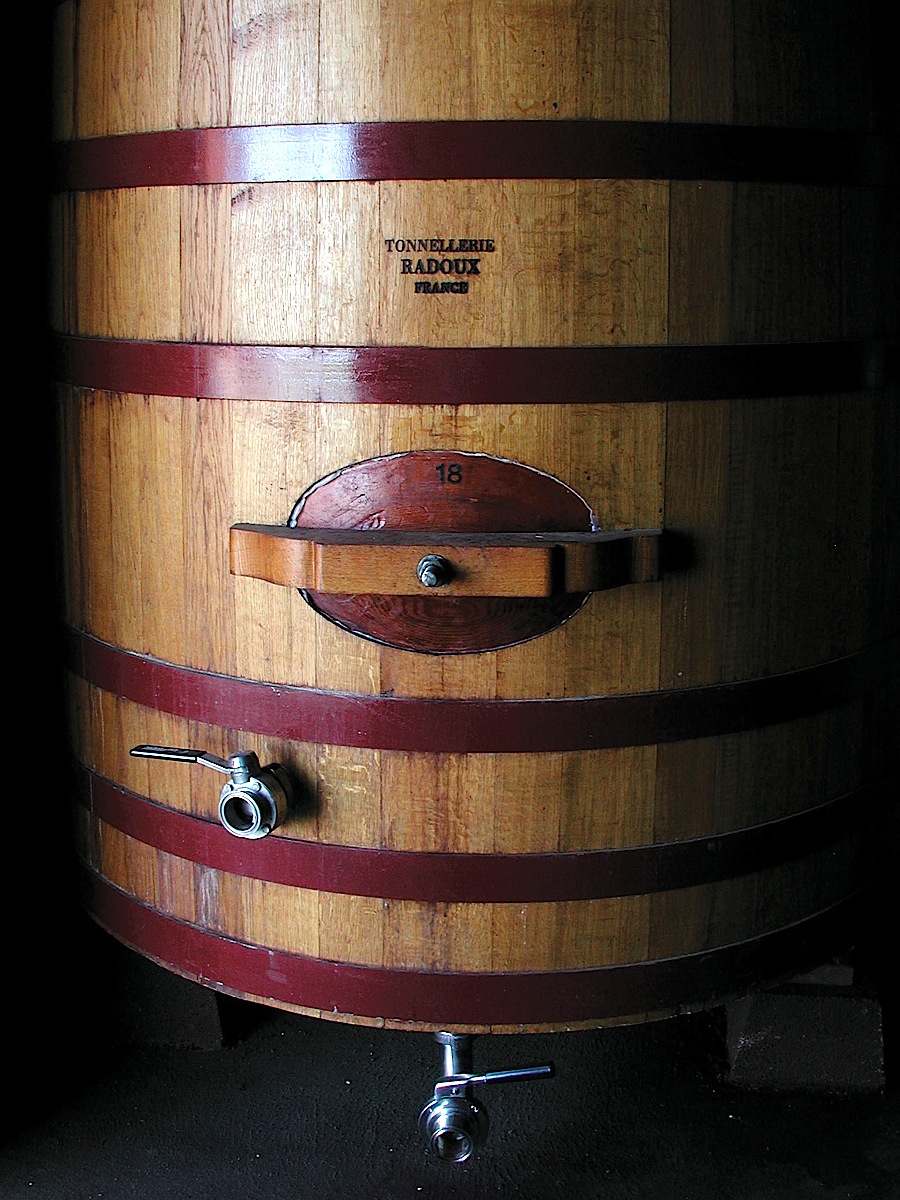 against the stream with Cambium,” he
said. “I’m going out holding my balls with this one,
but I think in six to seven years Cambium will really
stand on its own.
Funny thing is, when I raised the price at the
winery, I sold even more.” He’s
also hoping that he will find receptive sommeliers at
restaurants to buy the wine. “I’m looking for those
who want something different on their list because
they know who put it together.”
against the stream with Cambium,” he
said. “I’m going out holding my balls with this one,
but I think in six to seven years Cambium will really
stand on its own.
Funny thing is, when I raised the price at the
winery, I sold even more.” He’s
also hoping that he will find receptive sommeliers at
restaurants to buy the wine. “I’m looking for those
who want something different on their list because
they know who put it together.”
Given the improvements at
Sequoia Grove, I asked those authors who had not
included the winery in their books to see if they’d
had a change of mind. “Since 2007 my experience with
the wines has been good,” said Charles Olken, “they
seem to have hit their stride and their pricing is
very reasonable.”
“To be honest I haven’t tasted SG for many
years,” said Stephen Brook by e-mail. “But I used to
stop by regularly when in Napa 10-15 yars ago and
always enkoyed the wines - well, the reds are what I
remember. There's no plan for a new edition of the
book, so I have no idea whether SG would make the cut.
But I'll be in Napa in May and if I have time, will
stop by at the tasting room.”
I suspect Michael Trujillo will be rubbing his
hands when he reads that.
John Mariani's wine column appears in Bloomberg Muse News, from which this story was adapted. Bloomberg News covers Culture from art, books, and theater to wine, travel, and food on a daily basis.
❖❖❖
TRAVEL ARTICLES WE
NEVER FINISHED READING
“Ludwig
and I had the kind of relationship where I could ask
him anything without fear of reproach. I
questioned him about the rebellious rumblings of his
youth, his wishes for the future, and the state of his
bathroom. `Ludwig,’ I shouted from the
third-to-last-row of the tour bus, `Why don’t the
public restrooms here have toilet seats? Do you have a
toilet seat at home?’”—Andrea Sachs, “Cuba’s Door
Opening,” Washington
Post.
THE ICEMAN COMETH
Police in
Chile
have arrested a man on suspicion of stealing five tons
of ice from the Jorge Montt glacier in Patagonia to
sell as designer ice cubes in bars and restaurants.
The police intercepted a truck full of
Any of John Mariani's
books below may be ordered from amazon.com.
 |
My latest book, which just won the prize for best book from International Gourmand, written with Jim Heimann and Steven Heller, Menu Design in America, 1850-1985 (Taschen Books), has just appeared, with nearly 1,000 beautiful, historic, hilarious, sometimes shocking menus dating back to before the Civil War and going through the Gilded Age, the Jazz Age, the Depression, the nightclub era of the 1930s and 1940s, the Space Age era, and the age when menus were a form of advertising in innovative explosions of color and modern design. The book is a chronicle of changing tastes and mores and says as much about America as about its food and drink.
“Luxuriating vicariously in the pleasures of this book. . . you can’t help but become hungry. . .for the food of course, but also for something more: the bygone days of our country’s splendidly rich and complex past. Epicureans of both good food and artful design will do well to make it their coffee table’s main course.”—Chip Kidd, Wall Street Journal.
“[The menus] reflect the amazing craftsmanship that many restaurants applied to their bills of fare, and suggest that today’s restaurateurs could learn a lot from their predecessors.”—Rebecca Marx, The Village Voice. |
"Eating Italian will never be the same after reading John Mariani's entertaining and savory gastronomical history of the cuisine of Italy and how it won over appetites worldwide. . . . This book is such a tasteful narrative that it will literally make you hungry for Italian food and arouse your appetite for gastronomical history."--Don Oldenburg, USA Today. "Italian
restaurants--some good, some glitzy--far
outnumber their French rivals. Many of
these establishments are zestfully described
in How Italian Food Conquered the World, an
entertaining and fact-filled chronicle by
food-and-wine correspondent John F.
Mariani."--Aram Bakshian Jr., Wall Street
Journal.
"Equal parts
history, sociology, gastronomy, and just
plain fun, How Italian Food Conquered the
World tells the captivating and delicious
story of the (let's face it) everybody's
favorite cuisine with clarity, verve and
more than one surprise."--Colman Andrews,
editorial director of The Daily
Meal.com. "A fantastic and fascinating
read, covering everything from the influence
of Venice's spice trade to the impact of
Italian immigrants in America and the
evolution of alta cucina. This book will
serve as a terrific resource to anyone
interested in the real story of Italian
food."--Mary Ann Esposito, host of PBS-TV's
Ciao
Italia. "John Mariani has written the
definitive history of how Italians won their
way into our hearts, minds, and
stomachs. It's a story of pleasure over
pomp and taste over technique."--Danny Meyer,
owner of NYC restaurants Union Square Cafe,
Gotham Bar & Grill, The Modern, and
Maialino.
|
 |
 |
 |
 |
 |
 |
 |
 |
 Everett Potter's Travel Report:
Everett Potter's Travel Report: 
 Eating Las Vegas
is the new on-line site for Virtual Gourmet
contributor John A. Curtas., who since 1995
has been commenting on the Las Vegas food
scene and reviewing restaurants for Nevada
Public Radio. He is also the
restaurant critic for KLAS TV, Channel 8 in
Las Vegas, and his past reviews can be
accessed at KNPR.org.
Click on the logo below to go directly to
his site.
Eating Las Vegas
is the new on-line site for Virtual Gourmet
contributor John A. Curtas., who since 1995
has been commenting on the Las Vegas food
scene and reviewing restaurants for Nevada
Public Radio. He is also the
restaurant critic for KLAS TV, Channel 8 in
Las Vegas, and his past reviews can be
accessed at KNPR.org.
Click on the logo below to go directly to
his site.

Tennis Resorts Online: A Critical Guide to the World's Best Tennis Resorts and Tennis Camps, published by ROGER COX, who has spent more than two decades writing about tennis travel, including a 17-year stretch for Tennis magazine. He has also written for Arthur Frommer's Budget Travel, New York Magazine, Travel & Leisure, Esquire, Money, USTA Magazine, Men's Journal, and The Robb Report. He has authored two books-The World's Best Tennis Vacations (Stephen Greene Press/Viking Penguin, 1990) and The Best Places to Stay in the Rockies (Houghton Mifflin, 1992 & 1994), and the Melbourne (Australia) chapter to the Wall Street Journal Business Guide to Cities of the Pacific Rim (Fodor's Travel Guides, 1991).

nickonwine: An engaging, interactive wine column by Nick Passmore, Artisanal Editor, Four Seasons Magazine; Wine Columnist, BusinessWeek.com; nick@nickonwine.com; www.nickonwine.com.

MARIANI'S VIRTUAL GOURMET
NEWSLETTER is published weekly. Editor/Publisher: John
Mariani.
Contributing Writers: Christopher Mariani, Robert Mariani,
John A. Curtas, Edward Brivio, Mort Hochstein,
Suzanne Wright, and Brian Freedman. Contributing
Photographers: Galina Stepanoff-Dargery,
Bobby Pirillo. Technical Advisor: Gerry McLoughlin.
© copyright John Mariani 2012
